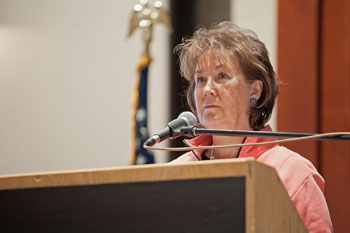By Lisa Yang

Linda Aitken, tribal liaison, addresses the audience at the 2011 Tribes and Transportation Conference in October. Photo by David Gonzalez |
Linda Aitken began her role as MnDOT’s tribal liaison when she joined the agency in June 2001. As one of the agency’s chief spokespersons, Aitken leads the agency effort in developing and maintaining relationships with all Minnesota Indian tribal governments, and works to foster a mutual understanding on issues affecting American Indian tribal communities.
Although her position is part of the Government Affairs Office located in St. Paul, Aitken primarily works at her home office in Walker; however, she often travels to meetings throughout the state.
How was the tribal liaison position created?
The idea for the tribal liaison position first came out of a specific project involving historic and cultural issues on a bridge replacement in Bemidji. The historic and cultural issues involved working with multiple tribes on a property that is historically significant to the Ojibwe and Dakota people.
The National Historic Preservation Act requires all federal agencies to consult with Indian tribes for undertakings that may affect properties of traditional religious and cultural significance on or off tribal lands.
MnDOT and Federal Highway Administration’s Minnesota Division posed the idea to the tribes about establishing a tribal liaison position within MnDOT. The responses from the tribes were overwhelming in their support to establish the position. The tribes were consulted and gave their input on the position description and the kind of person who should be hired.
Initially, the idea for the position was environmentally focused, but the work soon expanded to other areas the tribes considered equally important to their governments and people, such as employment, right of way, planning, safety and partnerships.
What types of issues do you deal with?
The issues that impact tribal governments and their communities are widely varied, including environmental, safety, right of way, employment, cultural, planning and necessary communications.
We work with the tribes on these issues through different venues, such as meetings with tribal governments at their reservations, annual conferences and quarterly Advocacy Council for Tribal Transportation meetings.
What are some of your accomplishments?
We’ve had the success of reviewing road signs on reservations, adding new signs for reservation boundaries and community identification, and also creating a reservation road sign brochure to provide information for the design and placement of signs on state highways.
On May 15, 2009, the Roadside Vegetation Memorandum of Understanding between MnDOT and Fond du Lac Band of Lake Superior Chippewa was signed. Because of that, Minnesota received FHWA’s Exemplary Human Environment Initiatives and Exemplary Ecosystem Initiatives award later that year for developing a process to manage vegetation without reliance on herbicides. Most tribes request that MnDOT not spray herbicides within reservations. The MOU is a model for all tribes and MnDOT districts in Minnesota.
I also helped establish the Advocacy Council for Tribal Transportation. This group discusses roadway policy and issues involving roadways on or near Indian reservations. Membership includes representatives from 11 Minnesota tribes, MnDOT, FHWA, the Bureau of Indian Affairs, Michigan Tribal Technical Assistance Program, Minnesota Indian Affairs Council, and Minnesota counties and cities.
What do you like most about your job?
What I like most about my job is that together, through understanding and cooperation, we have and are making a difference for the benefit of the tribal governments and communities, and for the good of all citizens of Minnesota.
On April 1, 2002, the tribal leaders, MnDOT Commissioner and FHWA Minnesota Division Administrator signed a Government to Government Transportation Accord. I believe it was evident at the 2011 Tribes and Transportation Conference in October that we’ve made tremendous advances toward the spirit of the accord.
What is most challenging about being the tribal liaison?
The challenge is to keep the forward motion. Developing and maintaining relationships with all Indian tribal governments that reside within Minnesota is an ongoing and continual process.
We recently heard from Erma Vizenor, chairwoman of the White Earth Nation, that education about tribes and tribal issues is nonexistent in Minnesota. There is a saying that goes, “Acquire wisdom; and with all your acquiring, get understanding.” So, my next goal is to help develop training to educate all MnDOT employees about tribal government and tribal issues.
Do you or a co-worker have an interesting job to share with readers? Click here to send us your ideas, and we’ll contact you for more information.
Recent employee profiles:
|



